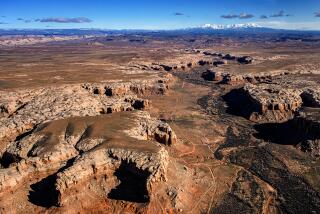State of the Wild goes unnoticed
- Share via
In anticipation of President Bush’s State of the Union address tonight, the Washington, D.C.-based Campaign for America’s Wilderness has released a State of the Wild report outlining pending and expected wilderness legislation in Congress. The four-page document, detailing laws that would affect more than 2.5 million acres in California and lands in the Arctic National Wildlife Refuge, Utah’s Red Rock Wilderness and the Wild Sky areas of Washington state, has been distributed to members of Congress, President Bush and the public, said Kathryn Seck, deputy director of communications for the group.
But like the proverbial tree falling in the forest, the document appears to be an unseen phenomenon. “I haven’t heard of it, sir,” said Pete Jeffries, communications director for House Speaker J. Dennis Hastert (R-Ill.).
“I have no idea why they wrote this,” said Nicole Andrews, spokeswoman for the Republican-controlled House Committee on Resources. “I’d be surprised if anyone in Congress will read this.”
Lori Ashley, field and outreach coordinator for the Wilderness Institute, a pro-protection group, said she was “not familiar with this document. It would be wonderful if it prompts the president to protect more lands, but I doubt it will.”
Campaign for Wilderness representatives believe the State of the Wild will bring awareness to areas that need more protection.
But critics charge the motive is politics. “This document has nothing to do with protecting public lands,” said Andrews. “It has everything to do with the fact that we are coming up on a campaign season.”
— Charles Duhigg
Remote surf spot draws mob
Cortes Bank is one of the most remote surf spots on the planet, a shallow seamount located 100 miles west of San Diego. It was first conquered by a group of tow-in surfers less than three years ago. Yet when a big swell hit early last week, it might as well have been down the road.
At least 18 tow-surfing teams arrived before or just after dawn to greet a swell that had been predicted almost a week earlier.
Most were big-wave veterans who came with jet-powered personal watercraft, safety equipment and even physicians. Some were novices who lacked even such basics as life jackets.
“In just less than three years it went from like taking the first steps on the moon to being the Barnum & Bailey Circus,” said Billabong Odyssey director Bill Sharp, who organized the first tow-in expedition at Cortes Bank on Jan. 19, 2001.
Billabong surfers Mike Parsons, Brad Gerlach, Shane Dorian and Noah Johnson added to the circus atmosphere when they arrived at the break via helicopter to meet their support vessel.
Cortes’ suddden popularity raises the question of safety on remote waves that averaged 25-35 feet during the session. The closest hospital is an eight-hour boat ride away for most vessels.
There were no serious injuries, but there were reportedly some close calls. Condor Express Capt. Ron Hart was accused by the Billabong crew of putting his vessel in harm’s way by maneuvering too close to the impact zone for the benefit of a film
crew that had chartered the vessel.
Hart denied the charge, saying, “My responsibility as a captain is the safety of our passengers.”
Sharp said he intended to turn video and photographs over to the Coast Guard.
— Pete Thomas






